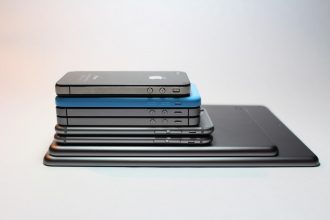
January 25, 2018
App Display Given the OK (Under 101)
On January 25, 2018, the CAFC affirmed a district court’s denial of a motion for summary judgment for invalidity under 101 in Core Wireless Licensing v. LG Electronics, Inc, and found the claims to be directed to patent eligible subject matter under 35 USC 101.
The claims addressed include the following (line breaks added for readability):
- A computing device comprising a display screen,
the computing device being configured to display on the screen a menu listing one or more applications, and
additionally being configured to display on the screen an application summary that can be reached directly from the menu,
wherein the application summary displays a limited list of data offered within the one or more applications, each of the data in the list being selectable to launch the respective application and enable the selected data to be seen within the respective application, and
wherein the application summary is displayed while the one or more applications are in an un-launched state.
- A computing device comprising a display screen,
the computing device being configured to display on the screen a main menu listing at least a first application, and
additionally being configured to display on the screen an application summary window that can be reached directly from the main menu,
wherein the application summary window displays a limited list of at least one function offered within the first application, each function in the list being selectable to launch the first application and initiate the selected function, and
wherein the application summary window is displayed while the application is in an un-launched state.
The district court held that the claims were “not directed to an abstract idea because, even crediting LG’s characterization of the claims as directed to ‘displaying an application summary window while the application is in an unlaunched state,’ the concepts of ‘application,’ ‘summary window,’ and ‘unlaunched state’ are specific to devices like computers and cell phones.” The district court also said that “LG identifie[d] no analog to these concepts outside the context of such devices” and that, “if claim 1 were directed to an abstract idea, it would still be patent eligible at least because it passes the machine-or-transformation test.”
One interesting point is that the CAFC noted that the claims would be patent eligible under 35 U.S.C. 101 (even if they were held to be directed to an abstract idea) simply because they passed the Machine or Transformation test. Note that in Biksli, the Supreme Court explicitly stated that “the machine-or-transformation test is a useful and important clue, an investigative tool, for determining whether some claimed inventions are processes under §101.” However, “[t]he machine-or-transformation test is not the sole test for deciding whether an invention is a patent-eligible ‘process.’”
Abstract idea
The CAFC said that “The asserted claims in this case are directed to an improved user interface for computing devices …” The CAFC also said that:
“Although the generic idea of summarizing information certainly existed prior to the invention, these claims are directed to a particular manner of summarizing and presenting information in electronic devices. Claim 1 of the ’476 patent requires ‘an application summary that can be reached directly from the menu,’ specifying a particular manner by which the summary window must be accessed. The claim further requires the application summary window list a limited set of data, ‘each of the data in the list being selectable to launch the respective application and enable the selected data to be seen within the respective application.’ This claim limitation restrains the type of data that can be displayed in the summary window. Finally, the claim recites that the summary window ‘is displayed while the one or more applications are in an un-launched state,’ a requirement that the device applications exist in a particular state. These limitations disclose a specific manner of displaying a limited set of information to the user, rather than using conventional user interface methods to display a generic index on a computer.”
In view of the above, the CAFC found the claims are directed to an improvement in the functioning of computers, analogous to the claims (held to be 101 patent eligible) in Enfish, Thales, Visual Memory, and Finjan. The CAFC again seemed to rely on the description/advantages over the prior art described in the underlying patents. The CAFC at length discussed what the patents themselves described as the prior art and the advantages over that described prior art.
Given the holding that the claims were not directed to an abstract idea, the CAFC did not touch on the second prong (inventive concept).
This case again illustrates that it may be important for patent drafters to include detail as to advantages provided by the the present claims and reasoning for pursuing the claimed subject matter.




































